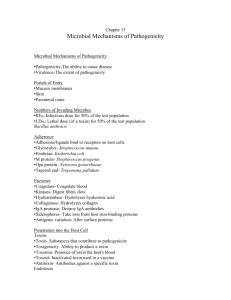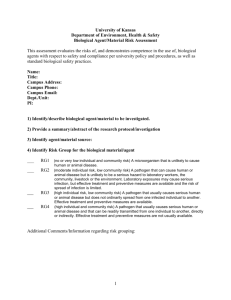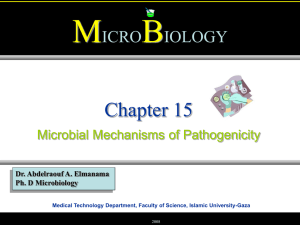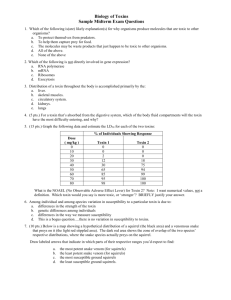Toxins of Biological Origin
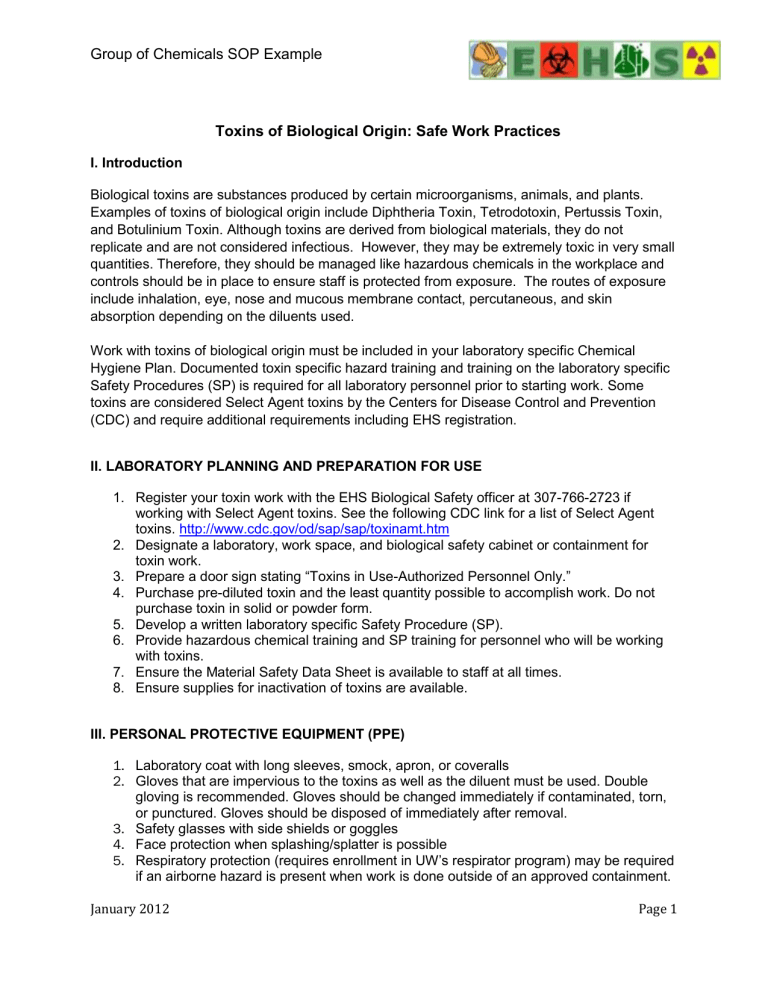
Group of Chemicals SOP Example
Toxins of Biological Origin: Safe Work Practices
I. Introduction
Biological toxins are substances produced by certain microorganisms, animals, and plants.
Examples of toxins of biological origin include Diphtheria Toxin, Tetrodotoxin, Pertussis Toxin, and Botulinium Toxin. Although toxins are derived from biological materials, they do not replicate and are not considered infectious. However, they may be extremely toxic in very small quantities. Therefore, they should be managed like hazardous chemicals in the workplace and controls should be in place to ensure staff is protected from exposure. The routes of exposure include inhalation, eye, nose and mucous membrane contact, percutaneous, and skin absorption depending on the diluents used.
Work with toxins of biological origin must be included in your laboratory specific Chemical
Hygiene Plan. Documented toxin specific hazard training and training on the laboratory specific
Safety Procedures (SP) is required for all laboratory personnel prior to starting work. Some toxins are considered Select Agent toxins by the Centers for Disease Control and Prevention
(CDC) and require additional requirements including EHS registration.
II. LABORATORY PLANNING AND PREPARATION FOR USE
1. Register your toxin work with the EHS Biological Safety officer at 307-766-2723 if working with Select Agent toxins. See the following CDC link for a list of Select Agent toxins. http://www.cdc.gov/od/sap/sap/toxinamt.htm
2. Designate a laboratory, work space, and biological safety cabinet or containment for toxin work.
3.
Prepare a door sign stating “Toxins in Use-Authorized Personnel Only.”
4. Purchase pre-diluted toxin and the least quantity possible to accomplish work. Do not purchase toxin in solid or powder form.
5. Develop a written laboratory specific Safety Procedure (SP).
6. Provide hazardous chemical training and SP training for personnel who will be working with toxins.
7. Ensure the Material Safety Data Sheet is available to staff at all times.
8. Ensure supplies for inactivation of toxins are available.
III. PERSONAL PROTECTIVE EQUIPMENT (PPE)
1.
Laboratory coat with long sleeves, smock, apron, or coveralls
2.
Gloves that are impervious to the toxins as well as the diluent must be used. Double gloving is recommended. Gloves should be changed immediately if contaminated, torn, or punctured. Gloves should be disposed of immediately after removal.
3.
Safety glasses with side shields or goggles
4.
Face protection when splashing/splatter is possible
5.
Respiratory protection (requires enrollment in UW’s respirator program) may be required if an airborne hazard is present when work is done outside of an approved containment.
January 2012 Page 1
Individual Chemical SOP Example
IV. TOXIN USE (reconstitution, dilution, administration)
1. Post sign on room door when toxins are in use stating “Toxins in Use-Authorized
Personnel Only ”.
2. Work with toxins in designated rooms with controlled access and pre-determined bench areas.
3. Prepare toxin in a biological safety cabinet (BSC) or other approved containment.
4. All potentially contaminated disposable items (gloves used in prep) must be placed in a plastic bag (while in the containment) and then in the chemical waste container for EHS pick-up.
5. Transport toxins in secondary, sealed, labeled, non-breakable containers.
6. Preparations should be performed over plastic backed absorbent pads. Dispose of immediately upon contamination.
7. Utilize safe sharps procedures (i.e. sharps container in the immediate vicinity, Leurlock syringes are recommended).
8. Before containers are removed from the hood, cabinet, or glove box, the exterior of the closed primary container should be decontaminated and placed in a clean secondary container.
9. Toxins should be transported only in labeled, leak/spill-proof secondary containers.
10. The BSC or approved containment must be cleaned upon completion of tasks.
11. Animals should be restrained or anesthetized when possible.
12. Wash hands upon completion of tasks.
13. Toxins should be stored in a secure location.
V. CLEANING SPILLS
1. Spills must be cleaned immediately by properly protected and trained personnel.
2. Liquid Spills: should be cleaned by personnel wearing a gown, goggles, and two pairs of gloves. Use absorbent pads to wipe liquid. Place waste in plastic bag and then in the chemical waste container for EH&S pick-up. The toxin and spill area should then be cleaned appropriately. See toxin inactivation section VII below.
3. Powder Spills: should be cleaned immediately by personnel wearing a gown, goggles, and two pairs of gloves. For powder spills outside of a fume hood or approved containment, non-essential personnel should be instructed to leave the laboratory and entrance should be restricted. In addition to the above specified PPE, A respirator
(requires enrollment in UW’s respirator program) should also be worn.
Page 2
Individual Chemical SOP Example
4. Place waste in plastic bag and then in the chemical waste container for EHS pick-up.
The toxin and spill area should then be cleaned appropriately. See toxin inactivation section VII below.
For questions on approaching a spill clean-up, contact the EHS RMMC at 307-766-3698 for guidance.
VI. ACUTE EXPOSURE
1. In case of skin contact or needlestick, wash the affected area with soap and water as soon as possible for at least 15 minutes.
2. For eye exposure, flush with water for at least 15 minutes. Then go to the Ivinson
Memorial Hospital Emergency Department.
3. Report incident to supervisor. Supervisor reports the accident/injury to UW Human
Resources.
VII. INACTIVATION AND DISPOSAL
1. Any used PPE and spill clean-up debris must be collected by EHS for disposal.
2. For mixed waste (i.e. toxin waste mixed radioactive waste) consult with EHS RMMC at 6-3698 for disposal instructions.
3. For waste pick-up, complete waste pick-up request form located at http://www.uwyo.edu/ehs/Waste_Management/Waste_Management.html
4. The below information on inactivation is from the Biosafety in Microbiological and Biomedical
Laboratories (BMBL) 5th Edition. Centers for Disease Control and Prevention. Appendix I:
Guidelines for Work with Toxins of Biological Origin. Please note that bleach solutions should be prepared fresh daily.
TABLE 1: PHYSICAL INACTIVATION OF SELECTED TOXINS
TOXIN STEAM
AUTOCLAVE
DRY HEAT (10 MIN) FREEZE-
THAW
GAMMA
IRRADIATION
Botulinum neurotoxin Yes a
Staphylococcal
Enterotoxin
Ricin
Microcystin
Saxitoxin
Yes e
Yes
No l
No l i
Palytoxin
Tetrodotoxin
No l
No l
> 100ºC b
> 100ºC; refolds f
> 100ºC i
> 260ºC m
> 260ºC m
> 260ºC m
> 260ºC m
No c
No g
No j
No n
No n
No n
No n
Incomplete d
Incomplete h
Incomplete k
ND
ND
ND
ND
Page 3
Individual Chemical SOP Example
T-2 mycotoxin No l
Brevetoxin (PbTx-2) No l
> 815ºC m
> 815ºC m
No n
No n
ND
ND
Table 1 Notes: ND indicates “not determined” from available decontamination literature. a Steam autoclaving should be at > 121°C for 1 h. For volumes larger than 1 liter, especially those containing Clostridium botulinum spores, autoclave at > 121°C for 2 h to ensure that sufficient heat has penetrated to kill all spores. b Exposure to 100°C for 10 min. inactivates BoNT. Heat denaturation of BoNT as a function of time is biphasic with most of the activity destroyed relatively rapidly, but with some residual toxin (e.g., 1-5%) inactivated much more slowly.
c Measured using BoNT serotype A at 20°C in food matrices at pH 4.1-6.2 over a period of 180 days.
d Measured using BoNT serotypes A and B with gamma irradiation from a Co source. e Protracted steam autoclaving, similar to that described for BoNT, followed by incineration is recommended for disposal of SE-contaminated materials. f
Inactivation may not be complete depending upon the extent of toxin re-folding after denaturation.
Biological activity of SE can be retained despite heat and pressure treatment routinely used in canned food product processing.
g SE toxins are resistant to degradation from freezing, chilling or storage at ambient temperature.
SEB in the freeze-dried state can be stored for years.
Active h. References 15,16 in BMBL
I
Dry heat of > 100ºC for 60 min in an ashing oven or steam autoclave treatment at >121ºC for 1 h reduced the activity of pure riacin by >99%. Heat inactivation of impure toxin preparations (e.g. crude riacin plant extracts) may vary. Heat-denatured ricin can undergo limited refolding (<1%) to yield active toxin. Ricin holotoxin is not inactivated significantly by freezing, chilling or storage at ambient temperature. In the liquid state with a preservative (sodium azide), ricin can be stored at 4ºC for years with little loss in potency. k
Irradiation causes a dose-dependent loss of activity for aqueous solutions of ricin, but complete inactivation is difficult to achieve; 75 MRad reduced activity 90%, but complete inactivation was not achieved even at 100 MRad. Gamma irradiation from a laboratory Co source can be used to partially inactivate aqueous solutions of ricin, but dried ricin powders are significantly resistant to inactivation by this method. l
Autoclaving with 17 lb pressure (121-132 o
C) for 30 min failed to inactivate LMW toxins. All burnable waste from LMW toxins sh ould be incinerated at temperatures in excess of 815°C (1,500 o
F).
m
Toxin solutions were dried at 150 o
C in a crucible, placed in an ashing oven at various temperatures for either 10 or 30 min, reconstituted and tested for concentration and/or activity; tabulated values are temperatures exceeding those required to achieve 99% toxin inactivation.
n
LMW toxins are generally very resistant to temperature fluctuations and can be stored in the freeze-dried state for years and retain toxicity.
Page 4
Individual Chemical SOP Example
TABLE 2: CHEMICAL INACTIVATION OF SELECTED TOXINS
TOXIN
Botulinum neurotoxin
NAOCL (30
MIN)
> 0.1%*
NAOH (30
MIN)
>0.25 N
NAOCL + NAOH
(30 MIN)
ND
OZONE
TREATMENT
Yes**
Staphylococcal enterotoxin
Ricin
Saxitoxin
Palytoxin
Microcystin
Tetrodotoxin
T-2 mycotoxin
Brevetoxin (PbTx-2)
> 0.5%***
> 1.0% #
≥ 0.1% ##
≥ 0.1% ##
≥ 0.5% ##
≥ 0.5% ##
≥ 2.5%e, ###
≥ 2.5%e, ###
>0.25 N
ND
ND
ND
ND
ND
ND
ND
ND
>0.1% + 0.25N ##
0.25% + 0.25N ##
0.25% + 0.25N ##
0.25% + 0.25N ##
0.25% + 0.25N ##
0.25% + 0.25N ##
0.25% + 0.25N ##
ND
ND
ND
ND
ND
ND
ND
ND
Table 2 Notes: ND indicates “not determined” from available decontamination literature.
* Solutions of NaOCl (≥0.1%) or NaOH (>0.25 N) for 30 min inactivate BoNT and are recommended for decontaminating work surfaces and spills of C. botulinum or BoNT. Chlorine at a concentration of 0.3-0.5 mg/L as a solution of hypochlorite rapidly inactivates BoNT (serotypes B or E tested) in water. Chlorine dioxide inactivates
BoNT, but chloramine is less effective.
** Ozone (>2 mg/L) or powdered activated charcoal treatment also completely inactivate BoNT (serotypes A, B tested) in water under defined condition.
*** SEB is inactivated with 0.5% hypochlorite for 10-15 mi.
# Ricin is inactivated by a 30 min exposure to concentrations of NaOCl ranging from 0.12.5%, or by a mixture of
0.25% NaOCl plus 0.25 N NaOH.
17
In general, solutions of 1.0% NaOCl are effective for decontamination of ricin from laboratory surfaces, equipment, animal cages, or small spills.
## The minimal effective concentration of NaOCl was dependent on toxin and contact time; all LMW toxins tested were inactivated at least 99% by treatment with 2.5% NaOCl, or with a combination of 0.25% NaOCl and 0.25N
NaOH.
### For T-2 mycotoxin and brevetoxin, liquid samples, accidental spills, and non-burnable waste should be soaked in
2.5% NaOCl with 0.25% N NaOH for 4 h. Cages and bedding from animals exposed to T-2 mycotoxin or brevetoxin should be treated with 0.25% NaOCl and 0.025 N NaOH for 4 h. Exposure for 30 min to 1.0% NaOCl is an effective procedure for the laboratory (working solutions, equipment, animal cages, working area and spills) for the inactivation of saxitoxin or tetrodotoxin. Decontamination of equipment and waste contaminated with select brevetoxins has been reviewed.
Alternate methods of chemical decontamination: 1N sulfuric or hydrochloric acid did not inactivate T-2 mycotoxin and only partially inactivated microcystin-LR, saxitoxin, and brevetoxin (PbTx-2). Tetrodotoxin and palytoxin were inactivated by hydrochloric acid, but only at relatively high molar concentrations. T2 was not inactivated by exposure to 18% formaldehyde plus methanol (16 h), 90% freon-113 + 10% acetic acid, calcium hypochlorite, sodium bisulfate, or mild oxidizing.
17
Hydrogen peroxide was ineffective in inactivating T-2 mycotoxin. This agent did cause some inactivation of saxitoxin and tetrodotoxin, but required a 16 hr. contact time in the presence of ultraviolet light.
Page 5
Individual Chemical SOP Example
Name (print) (Assessor):
Signature (Assessor):
Name (print) (PI, Lab Manager, or Unit Head):
Signature (PI, Lab Manager, or Unit Head):
Title:
Date:
Title:
Date:
Date Sent to EHS:
VIII. RESOURCES
1. Work with toxins of biological origin: EHS Department at 307-766-3277.
2. Spills: EHS-RMMC at 307-766-3698.
3. Waste collection and disposal information (including mixed waste which is a toxin waste mixed with radioactive waste) contact: EHS-RMMC online at: http://www.uwyo.edu/ehs/Waste_Management/Waste_Management.html
4. Biosafety in Microbiological and Biomedical Laboratories (BMBL) 5th Edition. Centers for Disease
Control and Prevention. Section VIII-G Toxin Agents, Appendix F: Select Agents and Toxins, and
Appendix I: Guidelines for Work with Toxins of Biological Origin. http://www.cdc.gov/od/ohs/biosfty/bmbl5/bmbl5toc.htm
Page 6

